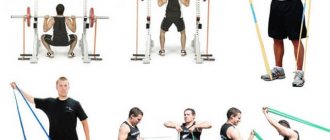Walking up stairs is practiced all over the world as an effective fat-burning and muscle-strengthening workout. Unfortunately, today more and more people lead an extremely sedentary lifestyle. They travel by car, sit in offices all day, and walk little. There is absolutely no time left for fitness or sports. As a result, heart diseases develop, muscles become flabby, excess weight and cellulite appear.
Walking stairs to lose weight or simply to maintain health is a way out for people trying to break the vicious circle. It can be practiced everywhere, for example, in the office, use the stairs instead of the elevator. At home you can also climb to your floor on foot. In shops, subways, and shopping centers, do not use escalators, but walk up and down with your feet. Thus, a person begins to lead an active lifestyle without wasting time training in the gym.
Of course, walking up the stairs will not replace a full-fledged workout in the gym. However, it will give excellent results to those who want to tighten the muscles of their legs and butts, strengthen their heart and lungs, and lose excess weight.
What muscles move when walking up stairs?
Let's find out which muscles are trained when walking up and down stairs. This will help you better understand the exercise itself, as well as why it is effective.
As you understand, descent and ascent are not the same thing. You will be surprised, but despite the fact that fewer calories are burned during the descent, the muscles work more intensely. The fact is that when a person rises, he moves his foot to a level elevation, intuitively calculating the height of the next rise. During the descent, each step is a small drop down, albeit to a certain depth. The brain and muscles work in conjunction; they constantly control the position of the body in space, experiencing a kind of stress. Thus, when going down, you strengthen and tone your muscles more, and when going up, you spend more energy, which means you lose weight.
Climbing up the stairs involves:
- Knee straighteners;
- Calf muscles;
- hamstrings;
- Gluteal muscles.
When descending, in addition to the indicated muscle groups, the quadriceps (front surface of the thigh) are included in the work.
Now you know which muscles work when walking up stairs, which means you understand why the exercise is so beneficial for the muscles of the lower body. By the way, such training involves movement, which means that many other muscle groups are involved - the back, arms, abdomen, and shoulder girdle. In addition, ligaments, joints and tendons are involved in the work.
Where can you go walking?
I'm sure there are plenty of stairs in all buildings, parks and, in extreme cases, gyms. So make the most of this opportunity.
In your house it is free, in your city there should also be stairs and more than one, they are also free. In the gym they are paid, but if you want to lose weight comfortably, then everything is in your hands.
Absolutely any staircase that consists of more than 5 steps will do.
Consider the option of the house in which you live. If you are afraid that your neighbors will think that your cuckoo has flown to warmer climes because you are running back and forth across the floors, then do it early in the morning or late in the evening. The city falls asleep, a juicy pie wakes up and begins its journey to a slender body.
Set a timer for 30 minutes and walk up and down. The main disadvantage of this option is that you may feel dizzy. But after such training you can fly into space, your endurance increases greatly. The main thing is that the spacesuit fits on your still massive thighs.
Let's also remember your place of work.
If this is some kind of high-rise building, then by giving up the elevator, you will not only lose weight, but also make happy people who are late for work in the morning, perhaps even because of you.
The fact is that the elevator can accommodate a certain number of people and it has a maximum weight. By using a ladder, you allow two or even three people to get to their workspace a little faster. So far there are only advantages.
Next is one of the best options. This is any staircase in your city. For example, in the park. Usually these are long and tall stairs with wide steps. You can walk up and down on them without getting dizzy. And this is an outdoor workout, just wonderful.
As a last resort, you can come to the gym and stand on a machine that simulates walking on stairs . But such miracles are not found in all halls.
I advise you to choose wide steps so that you can take a wider step, or take a step every other step. This will increase energy expenditure and allow you to tighten your hamstrings and gluteal muscles.
If you walk in small steps, you work mainly the front of the thigh and calf muscles.
Execution technique
To get started, check out these helpful tips.
- First of all, be sure to do a warm-up - warm up the muscles of your legs and back. Perform circular rotations of the working joints, jump in place, stretch well;
- Work out in comfortable sportswear, don’t skimp on high-quality sneakers with springy soles;
- Start the lesson at a slow pace, gradually increasing it towards the middle. The last 10% of the time, slow down smoothly. Finish the workout with a small stretching routine and breathing exercises;
- While walking, breathe regularly and take moderate deep breaths. Inhale through your nose, exhale through your mouth.
- The recommended heart rate zone is 130-140 beats. /min. You can download a special fitness application to your phone or buy a fitness watch;
- For those who want to take the stairs to lose weight, for quick results, reviews recommend doing it at the fastest pace you are capable of.
- Take breaks only after going down: you go up, immediately go down - you can sit for a while.
During the movement, the leg is placed on the toe, rolling the foot onto the heel, the knee is bent to an angle of 90 degrees. The back is kept straight, the body can be slightly tilted forward while lifting. It is advisable to bend your arms at the elbows and use them to help the movement. Don't look at your feet. Put headphones in your ears – it’s more fun!
Read more about the benefits of climbing stairs
Despite its apparent simplicity, climbing stairs has a complex effect on the entire body.
With this exercise you will be able to:
- Lose weight
. In terms of intensity, climbing stairs is superior to classic jogging and squats. Moreover, calories are burned both during the ascent and during the descent, so that not a single movement will be useless. - Strengthen muscles
. Walking up the stairs forces even those muscles that are practically not used in everyday life to work. This way you will tone even the riding breeches area, back and abdominal muscles. - Get rid of shortness of breath and increase endurance.
With regular exercise, your lung capacity will increase, and climbing flights of stairs will become much easier. And long-distance walks will become much more enjoyable. - Extend lifespan.
Studies have shown that a twenty-minute workout can increase life expectancy by an average of 3 years. - Reduce your risk of stroke and cardiovascular disease.
Compared to people who take the elevator, those who take the stairs are 29% less likely to suffer from heart disease. - Reduce stress levels.
Physical activity is the best cure for emotional fatigue, burnout, stress, and insomnia. Especially if your job is sedentary and involves constant mental stress.
Benefits, harms and contraindications
Next, we will consider the benefits and harms of walking up the stairs, because this exercise, like any other, has its contraindications. Let's start with the pleasant things:
- Cardiologists unanimously answer the question “is it useful to walk up the stairs?” Exercise strengthens the cardiovascular system, normalizes blood pressure;
- The exercise trains the athlete’s endurance and improves breathing;
- Muscles and joints are strengthened, a beautiful relief appears, the body becomes more elastic, the skin is elastic;
- The exercise is classified as energy-intensive, so it actively promotes fat burning. Below we will tell you how to properly walk up the stairs for weight loss so that the result appears as soon as possible;
- Blood circulation is activated, especially in the pelvis, which is equally beneficial for the reproductive function of both men and women;
- Beautiful posture is formed;
- Any sports activity has a positive effect on a person’s overall emotional background - the mood rises, worries and worries fade into the background.
In what cases can walking on stairs harm an athlete?
- If you set the bar too high for yourself and start training at a very fast pace, you may experience unusual pain in your heart or joints. In this case, reduce the load and allow yourself to rest. Be sure to see a doctor;
- If you exercise in unsuitable shoes, you can injure your ankle joint. The risk of falling and twisting a leg remains for beginners who are not yet accustomed to the exercise, or who immediately practice high speed;
- If you exercise while feeling unwell, there is a risk of shortness of breath, dizziness, and weakness. Never go to training if you are sick, have a cold, have not slept well, or are very tired.
Below we list contraindications, in the presence of which walking on stairs is strictly prohibited:
- Active varicose veins;
- Conditions after a heart attack or stroke;
- Injury to the knee, ankle or hip joints. Please note that it must be diagnosed by a specialist. If your knee hurts after running, this does not mean anything and it is too early to talk about contraindications;
- Damage to the musculoskeletal system;
- Scoliosis;
- Exacerbation of chronic diseases;
- After abdominal operations;
- In inflammatory processes, including fever;
- Glaucoma;
- Severely poor vision.
Advantages and disadvantages of the method, contraindications
Advantages of losing weight by walking on stairs:
- Burns a lot of calories (more than walking, dancing and swimming).
- Fast weight loss. When you walk up stairs, fat is broken down and water is lost. This promotes rapid weight loss. In one workout you can lose 500-700 g of weight.
- Availability. You don't need to join a gym or hire a trainer. This is convenient if there is no forest park nearby in which you could run in the fresh air.
- Strengthening the cardiovascular system. Regular physical activity trains the heart muscle, so the heart begins to push a larger volume of blood in one contraction. At the same time, the number of blood vessels increases and their walls become stronger. And this is a good prevention of varicose veins.
- Increased endurance. Regular training increases a person's physical fitness. His body becomes more resilient. This allows him to gradually increase the time he walks on stairs to lose weight.
- Strengthening the muscles of the legs. After 2-3 workouts, you will notice that the muscles are noticeably tightened. And after 2-3 months, your legs will look athletic.
The disadvantages of walking up stairs for quick weight loss include:
- Lack of fresh air;
- Large load on the heart (dangerous for unprepared people);
- Heavy load on the knees and other joints of the legs;
- There are contraindications to this type of exercise.
Contraindications for walking up stairs to lose weight include:
- High blood pressure;
- Pregnancy;
- BMI (body mass index) above 33;
- Heart diseases;
- Varicose veins of the legs;
- Scoliosis (curvature of the spine);
- History of injuries (if you have previously had bone fractures, you should not overload your legs).
Be sure to read: Effective exercises for weight loss with fitball
Before you start training, check your health and consult with your doctor.
Walking on stairs and pregnancy
Many expectant mothers, especially those who have recently led an active sporting life, are interested in the benefits of walking up stairs for women. And in general, is it possible to organize such training in an interesting situation?
The answer to this question will be positive, because pregnancy is not a pathological condition. On the contrary, this is a wonderful period when moderate physical activity will have a positive effect on both the woman and her baby.
- During exercise, the body absorbs more oxygen. Thus, the expectant mother, with the help of exercise, negates the risk of the baby developing hypoxia;
- Physical education strengthens muscles and ligaments, improves well-being, which means it will be easier for mom to give birth and easier to recover after childbirth;
- Of course, the load for pregnant women should be moderate. No weights, new records or tiring races. If you suddenly feel unwell, stop immediately. Exercise slowly and have fun. You will lose weight and get a bigger butt later, but now, you just need to improve your health and cheer yourself and your baby up.
- Be sure to consult your doctor before starting exercise. It is forbidden to play sports if there is a threat of miscarriage, uterine tone, bleeding, pain, or in the early stages.
- In the last trimester, we recommend wearing compression garments and a bandage.
How to burn calories and fat while climbing stairs?
1. Before starting the lesson, it is advisable to do a short warm-up of all muscles, as well as “warm up” the knee joints.
You should start by going up to at least the 3rd floor, increasing the number of ascents and floors over time. At first, the duration of the workout should be 10-20 minutes. 2. If it’s hard for you to climb 9 floors at once, then use the interval method: you climb for 30 seconds, and then rest for 30 seconds. So train for half an hour. 3. When climbing, do not rush. Thus, scientists concluded that walking one step at a time is considered more effective than walking one at a time. An even slow rise helps the growth of muscle tissue, and a fast rise leads to the burning of fat cells.
4. You can burn calories not only while walking up the stairs, but also when going down. Even if the energy consumption is lower, you will be able to burn at least 200-300 kcal per hour.
Note:
After 2-3 months of regular stair training, you can add weights such as dumbbells, water bottles or a backpack.
How many calories can you burn?
If you forget about elevators, escalators and other means of easy lifting, then you will have an excellent opportunity to spend from 600 to 800 kcal per hour. Descent takes slightly less energy - about 200 kcal/hour.
How to implement a habit into your life?
To begin with, you should not, as they say, rush into all seriousness. Start your “staircase” training by doing 2 ascents and descents to the 3rd-4th floor in the first week. This will take you approximately 15 minutes. Each week, add 1st floor until the workout lasts 40-45 minutes. Such full-fledged walking on the stairs can completely replace a workout in the fitness center. Also, you should not limit yourself to the usual stairs in your apartment building. You can use the steps at the stadium or any other place convenient for you. Don't forget that in addition to losing weight and toning your muscles, you will become stronger and healthier. Read more in one of the articles about training to develop endurance.
How many calories are burned?
All women who are losing weight are interested in how many calories are burned when walking up the stairs. By the way, this exercise takes much more energy than regular jogging, because during the lifting process the athlete is forced to constantly overcome the force of gravity.
- On average, a person spends 1 kcal for every 10 steps;
- Thus, at a moderate pace, he will burn 10-15 kcal per minute;
- Using simple calculations, we calculate that you can lose 600-900 kcal in an hour
Energy expenditure depends on many factors, such as the weight of the athlete. The more a person weighs, the more difficult it is for him to carry his kilograms up the stairs, and accordingly, the more calories he will spend. Also influenced by the speed of movement, the duration of the activity, and even the air temperature in the area.
As you can see, walking up the stairs is effective for losing weight - calories are burned more actively than when running (500-600 kcal per hour). By the way, when the initial load becomes familiar to you, try to speed up the pace or switch from walking up the stairs to running. Or, start using weights. This will increase the difficulty of the task, which means you will burn many more calories. If you are trying to lose weight, remember to eat healthy, get enough sleep and rest.
How many calories are burned while walking: formula and calculation example
To calculate how many calories are burned when climbing stairs to the 5th, 9th or 10th floor, you will need the following basic data:
- Own body weight in kilograms (denoted by the letters “MT”);
- The height of one step of the staircase in meters (in the formula it corresponds to the designation “BC”);
- The number of steps on a flight of stairs between two adjacent floors (denoted by the abbreviation “KS”);
- The number of floors in the house (briefly denoted “KE”).
Formula for calculating energy consumption (“RE”): RE=MT*10*VS*KS*(CE-0.5).
Attention! Subtract 0.5 from the number of floors. This is due to the fact that the flight of stairs to the first floor is 2 times shorter than from the first to the second, etc.
Using the above formula, you can calculate your calorie expenditure in joules. This unit of measurement is commonly used in physics. But human energy expenditure is usually measured in calories. To get energy consumption in calories, you need to divide the calculation result using the formula by 4.2, and in kilocalories, divide it by another 1000.
Calculation example
Let's calculate how many calories a person weighing 100 kg burns when climbing to the 9th floor on a staircase with a step height of 20 cm and 18 steps between two adjacent floors:
- Multiply the mass by 10. 100*10=1000.
- We multiply the resulting number by the height of the steps in meters (20 cm = 0.2 m). 1000*0.2=200.
- We multiply the resulting number by the number of steps between the two floors. 200*18=3600.
- Now we subtract 0.5 from the number of floors and multiply the result of the previous calculation by the resulting number. 9-0.5=8.5. 8.5*3600=30600. This is the amount of energy spent on lifting in joules.
- Let's convert it into calories. To do this, divide the result of the previous calculation by 4.2. 30600:4.2=7285 calories (approximately).
Since human energy consumption is calculated in kilocalories, we divide the resulting number by 1000. It turns out that while climbing to the 9th floor, a person weighing 100 kg spends approximately 7.3 kcal.
Is energy wasted during descent?
Once you reach the maximum floor, you will have to go back down. This also requires energy. But it is consumed 3 times less during descent than during ascent.
Example. Having climbed to the 9th floor and descended from it, a person weighing 100 kg spends approximately 10 kilocalories.
How many calories can you burn in one workout?
It all depends on the speed of movement on the stairs and the duration of the workout. Let's give 2 examples for the same person weighing 100 kg:
- Slow walking. Suitable for untrained people. For example, going up to the 9th floor and coming down from it takes 3 minutes. This means that in 30 minutes there will be 10 ascents and descents. Then 100 kilocalories will be consumed in half an hour, and 200 in an hour.
- Fast walking (almost running). Suitable for trained people with a strong cardiovascular system. For example, each descent and ascent takes 1 minute. Then in 30 minutes the person losing weight will rise and fall 30 times, and this is already 300 kilocalories, and in an hour – 600.
Be sure to read: When is it more effective to exercise for weight loss?
You can burn about the same amount of energy while jogging or jumping rope.
Sample lesson program
If you have just started training, do not take weights. Exercise 2-3 times a week for 15-30 minutes at a slow pace. After a couple of weeks, you can increase your walking speed.
For athletes with normal physical shape, we recommend adding light exercise elements to walking up stairs:
- Jumping up – 20-30 times;
- Tiptoe lifts 40-70 times;
- Swing your legs forward, backward and to the sides 30 times;
- Next, walk up the stairs for 10-15 minutes at a moderate pace;
- 5-10 minutes brisk walking (almost running);
- 10 minutes gradually reduce walking speed.
- Several stretching exercises.
For experienced athletes, we recommend making the task more difficult for themselves, for example, hanging a backpack with weights on their backs, or picking up dumbbells. Try interval running at alternating speeds.
We studied reviews and results about walking on stairs for weight loss, and concluded that the exercise is very effective. Women who purposefully go to stadiums to run up and down the stairs say they were able to lose 5 to 10 kg in a month. At the same time, of course, they followed a proper diet, drank a lot of water and combined walking up the stairs with other exercises.
As they say, the one who walks can master the road, which means the main thing is to start training. Try it today, away with the elevator, walk up home!
How to walk up stairs correctly for weight loss
Basic principles of losing weight by walking up stairs:
- To burn fat, you need to eat no later than 1 hour before training. Otherwise, energy will be taken from the last meal rather than from fat reserves.
- The workout should last at least 30, but no more than 60 minutes. First, glucose stored in the blood after eating, as well as glycogen stored in muscle tissue, are used to release energy. The transition to fat burning occurs 20 minutes from the start of the workout. If you walk for more than 1 hour, your muscles begin to break down. This cannot be allowed.
- You need to do at least 3 workouts per week. With good physical fitness and quick recovery, you can walk up the stairs every day.
- While walking up the stairs, you need to maintain an optimal heart rate (heart rate, or heart rate) for fat burning. To calculate it, subtract your age in years from 220. First multiply the result by 0.6 and then by 0.7. You will get a heart rate range at which active breakdown of adipose tissue occurs.
An example of calculating the optimal heart rate range for a person aged 30:
- Subtract age from 220. 220-30=190. This will be your maximum heart rate. It cannot be exceeded, it is dangerous for the heart.
- Multiply 190 by 0.6. 190*0.6=114. This is the minimum heart rate that supports the fat burning process while walking up the stairs.
- Multiply 190 by 0.7. 190*0.7=133. This is the upper limit of the heart rate. If it is exceeded, muscle tissue will be destroyed, not fat tissue.
During training, you should try to keep your heart rate in the range that was obtained in the calculations. But it doesn't have to be done with high precision. So, the calculations above can be rounded. Then the range expands: from 110 to 135 beats per minute.
Be sure to read: Techniques for performing exercises for weight loss on the street and what is necessary for them
Advice! Adjust your heart rate by decreasing or increasing your speed on stairs. With each new workout, your heart will become stronger.
Therefore, over time, you will be able to run up the stairs, and your heart rate will not exceed the optimal range for fat burning.
Walking on stairs for untrained people
Half-hour workouts are difficult for people with poor physical fitness. Therefore, you need to increase the load gradually. Approximate load increase scheme:
- On the first day, walk up the stairs very slowly for 10 minutes. You can go up and down only 2-3 times. But for the first time this will be enough.
- On the second day, do 1 more up-and-down cycle, and on the third, 1 more, etc., until the workout time is 30 minutes.
- Next, continue to increase your training time to 60 minutes, and also increase the speed of climbing stairs.
- Monitor your pulse. If it's too slow, speed up; if it's too fast, slow down.
After training, do not stop abruptly. Continue moving until your heart rate returns to normal and your breathing is restored.
To do this, take a leisurely walk down the street, taking deep breaths through your nose and slowly exhaling through your mouth.










